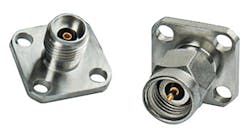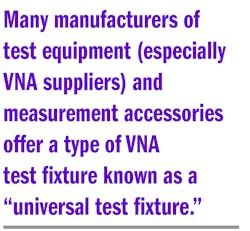Microwave test instruments can be quite elegant in their design and construction. Such is the case for vector network analyzers (VNAs), with their capabilities to measure the scattering parameters (S-parameters) of high-frequency circuits, components, and devices now well into the millimeter-wave frequency range.
For all their electronic precision and wide dynamic ranges, modern commercial VNAs often rely on solid mechanical engineering, in the form of RF/microwave test fixtures. These perform accurate measurements on different types of chip and packaged high-frequency devices and components not equipped with coaxial connectors that provide an easier interface to the VNA. A VNA test fixture can have a great deal to do with the accuracy of VNA measurements on miniature components and devices, such as those supplied in surface-mount-technology (SMT) packages, and the choice of VNA test fixture should never be taken lightly.
The current trend in designing smaller and more densely packaged RF/microwave circuits is supported by smaller passive components, semiconductor devices, and even microelectrical-mechanical-systems (MEMS) components like switches, which are being supplied in die form or in extremely small SMT packages. In many cases, component or device suppliers may integrate a sample of a device under test (DUT) onto a high-frequency printed-circuit board (PCB) with coaxial launchers for connection to a VNA.
This is a tremendous convenience in terms of characterizing the product to obtain S-parameters for circuit design purposes, assuming that the sample circuit is well designed and incorporates coaxial connectors that are compatible with an owner’s VNA.
Many of these same manufacturers of miniature components and devices back their products with technical support departments, providing technical support to customers in the form of their own test fixtures for characterizing their products on an RF/microwave VNA. Such test fixtures may be constructed for use with a particular package type, with interconnections to the PCB circuitry and launching connectors that match the lead configuration for a particular product.
If such a test fixture is used for other devices or components from the same manufacturer and in the same package, steps should first be taken to make sure the lead configurations of the packaged part are compatible before testing. In addition, even when testing a considerable number of the same product in the same package, repeatability will depend on proper handling of the manufacturer-supplied test fixture and its launching connectors.
Many manufacturers of test equipment (especially VNA suppliers) and measurement accessories offer a type of VNA test fixture known as a “universal test fixture.” This implies that is can be used for testing any number of different components and devices—such as those in pin-mounted packages and those in SMA housings—and that it includes bias lines along with signal input/output (I/O) interconnections for testing active devices and integrated circuits (ICs). Such general-purpose test fixtures typically provide provisions for working with different types of transmission-line circuits on PCB circuit materials with different thicknesses, using mechanical approaches (such as spring-loaded force) to secure a DUT in place.
Some manufacturers of specialized VNA test fixtures, as well as test-equipment manufacturers, even provide “do-it-yourself” test fixtures that allow a user to assemble a configuration that may provide an optimum fit for a particular package. That being said, such test fixtures are typically geared for lower-volume testing and may lack the repeatability required for higher-volume production testing.
VNA test fixtures come in many forms and for many purposes. Some, for example, are designed specifically for high-power testing of large-signal transistors and some for characterizing high-power pulsed components for radar systems. In all cases, a VNA test fixture that is best doing its job is electrically “invisible” within the test system and serves only to interconnect the DUT in the most effective way possible to the VNA’s test ports. Careful consideration should be given to the role of the test fixture in the test system, especially where higher accuracy and repeatability are required.
As noted in a previous blog, high-frequency connectors become more minute with increasing frequencies and more subject to damage, and thus must be treated with care to maintain acceptable and repeatable levels of electrical performance. This is true in general for all VNA test fixtures—especially those being connected and reconnected to a VNA’s test ports, as in production testing.



